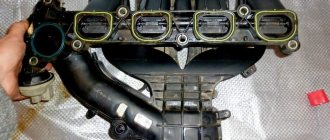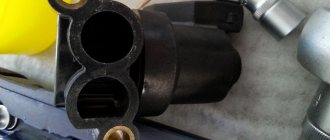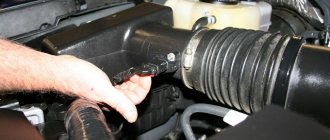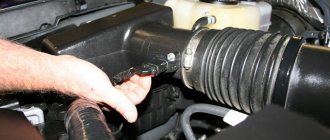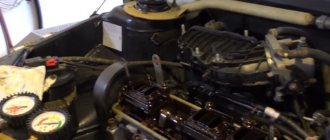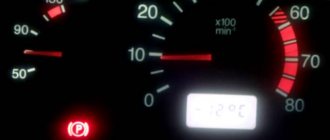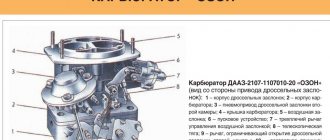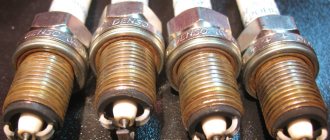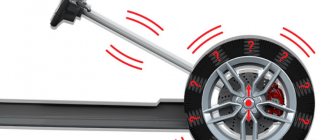About the Wheelbarrow ⁄ Maintenance and repair ⁄
Many owners of used cars are familiar with the problem of “floating” idle speed. A similar problem can occur both on very old cars that are equipped with a carburetor, and on more modern ones that already operate on an injector. Let’s immediately make a reservation that solving the problem on a carburetor engine is much cheaper and easier, but we will try to find out what the situation is with injection engines.
First, you need to pay a little attention to the design of the injector. If we draw an analogy with a carburetor, then, in simple language, we can say that the carburetor has completely mechanical control, i.e., the driver himself controls the suction, adjusting the force of air supply to the engine cylinders. In the injector, all “mechanical” responsibilities are taken over by the electronics. Of course, electronics, or a microcomputer, carries out control using several installed sensors, and if the latter begin to work incorrectly, or stop working altogether, problems with speed begin, since the control computer simply cannot determine what to do.
Idle speed on an injection engine
To solve this problem, you need to understand how idle speed works on an injection engine.
The entire operation of a modern power unit is controlled by an electronic unit (ECU), which uses the readings of various sensors installed on the engine crankcase. Several such parts are responsible for idling, namely:
- idle speed control valve;
- a sensor responsible for regulating the throttle position;
- air flow meter entering the intake manifold (MAF);
- EGR exhaust gas afterburning valve.
Each of them has a specific functionality and can affect the engine speed without load. The ECU receives data from these nodes and, processing it, selects the optimal operating mode of the car engine.
Sometimes the cause of a malfunction in which the idle speed drops may be the failure of any sensor. In case of such a breakdown, it is best to contact a car service station, which has specialized diagnostic equipment and is able to quickly identify the defective part. If this is not possible, you will have to conduct your own search. And they should start with the idle speed control valve.
Engine speed fluctuates: symptoms and main causes
First of all, the tachometer helps to notice floating speed. Most often, the floating speed appears at idle. Normally, even on a slightly warmed-up engine, the tachometer needle should remain stable at about 800 rpm while idling.
The only exception is the warm-up speed XX, when the ECU on injection engines itself raises the speed to 1000-1100 rpm. In this case, after the engine temperature rises slightly, the control unit will lower the idle speed to the desired level of 750-800 rpm.
Also, jumps in speed can be observed if you increase the load on the engine (press the brake pedal, turn the steering wheel in a car with hydraulic booster, turn on the air conditioning or climate control, etc.). The revolutions may also fluctuate while driving in transition modes.
In this case, without additional load, the engine can keep the speed stable at idle, but as soon as the load appears, the speed drops, and the engine almost or completely stalls.
The driver may also notice a significant increase in fuel consumption, the engine response changes when exiting transient modes, jerks and dips may occur during acceleration, etc.
Idle air control valve or IAC
The IAC is a small electric motor in which a cone-shaped needle is placed on a spring. It is designed to supply air to the engine power system, which is necessary to form the proper quality of the air-fuel mixture, making it lean. It is connected to the mass air flow sensor and, receiving a signal from the ECU, opens, providing air flow without using the throttle valve, which changes position when the gas pedal is pressed.
Having rather fragile parts and being located in the engine intake manifold, the regulator is subject to the formation of various deposits on the needle, which impedes its movement, which leads to failure of this part.
Checking the performance of the IAC is quite simple; to do this, you need to use a tester and check its resistance readings on a warm engine. The operating resistance should be in the range from 40 to 80 ohms. If it is not, then it is faulty and needs to be replaced.
Another characteristic sign of a regulator failure is that when the engine is hot, it begins to stall as soon as the gearbox is switched off while driving.
The IAC cannot be repaired, so it is simply replaced with a new part. If the regulator resistance indicator is normal, then it is worth checking the mass air flow sensor.
Tips and tricks
Let's look at how you can eliminate some of the malfunctions that lead to floating and speed jumps, and do it yourself.
- As mentioned above, the leakage of excess air can cause surges. To exclude or confirm the possibility of supplying such air, you need to check the tightness of the air supply system to the intake. You can remove the air hose and feed it air from a compressor or pump by placing the hose in a container of water. This method helps to identify cracks.
- As for the idle air control, you need to measure the resistance with a multimeter. If the resistance is between 40 and 80 ohms, this means that the device is not working.
- Also, as part of diagnostic procedures, in some cases it is necessary to clean the crankcase ventilation valve. The valve must be removed and washed with carburetor cleaning fluid or kerosene. This approach will remove deposits from the valve.
- As for the ECM sensors, in this case it is not advisable to try to repair such elements. For example, if the mass air flow sensor is faulty, it is better to immediately replace it with a new one.
- It is better to trust specialists to flush the throttle valve without proper experience, especially if such flushing is necessary with the removal of the valve. If we talk about the method of flushing the throttle without removing it, you can do the procedure yourself. The hoses are disconnected from the valve, then a cleaning aerosol is injected into the throttle.
The main thing is to disconnect the electrical contacts from the throttle valve. Let us add that on many cars where the damper was heavily dirty, you then need to additionally set the correct opening gap of the damper or “teach” the throttle using the appropriate equipment.
- On a car with a carburetor, you need to adjust the idle speed by setting it with the quality and quantity screws on the carburetor. The idle jet may also need to be cleaned. To do this, it is often enough to inject a carburetor cleaning aerosol and then blow it with compressed air.
According to drivers, this helps protect the pump from corrosion and is a preventative measure. At the same time, we note that this method is suitable for construction equipment and it is highly not recommended to practice such solutions on modern diesel internal combustion engines.
The role of the mass air flow sensor (MAF)
This device is designed to measure air, a certain amount of which is supplied to the manifold for mixing with gasoline. In appearance, it is a metal mesh and a measuring element placed in it with a four-pin power connector. The measuring element is equipped with a platinum string, which acts as a heat exchanger. It is cooled by the air flow coming from the air filter, and heated by supplying electricity to it; the stronger the air flow, the more electricity is supplied to the platinum.
If the DMVR fails, the electronic unit does not receive a signal about the incoming air volume, and the unit is not able to provide the required engine operating mode.
It is not difficult to check it on a warm engine; to do this, you need to disconnect the power connector from the sensor and start the engine. With this option, the electronic unit will select emergency mode and increase the number of crankshaft revolutions to 1500 per minute. After driving a car for several kilometers and realizing that the car has become much more responsive, you can identify a malfunction of the mass air flow sensor and the need to replace it.
To be more convincing, you can use a tester, switching it to the maximum two-volt constant voltage mode. After that, turning on the ignition in the car, the red wire of the tester is connected to the yellow wire of the mass flow sensor connector, and the black wire to the green. The tester should show a value from 101 to 103, which means that it is working. If above 105, the sensor is faulty and requires replacement.
The cause of failure of this part is most often an excessively clogged air filter and a malfunction of the crankcase ventilation of the power unit.
It's time to service the carburetor - minor defects
The reason for the drop in speed during warming up can also be minor breakdowns in the carburetor system. These are torn membranes, dislodged cable fastenings or a sticking damper drive. Such troubles can be cured during an inspection of this device. In the old days, every second car driver could independently rebuild the carburetor, install a repair kit and drive on, listening to the contented rumbling of the unit. Today the repair principle is as follows:
- you should go to a car store or market to find a suitable repair kit for your type of carburetor; it is better to take original high-quality parts;
- Next, it is important to find a master who is well versed in carburetors and can help with troubleshooting problems in your device; there are fewer and fewer such masters in cities;
- In a few tens of minutes, a specialist will go through the equipment, find the problem and install new gaskets, membranes, seals and other products from the repair kit;
- Next, you need to check the equipment to make sure there are no unpleasant effects; often this can only be done the next day on a cooled car;
- the last step is regular visits to the technician once every 2 years for maintenance and inspection of the carburetor, this will keep the car in normal working condition for a long period.
Carburetor fuel injection has its advantages. You will have to pay a fortune for maintenance and cleaning of the injector. But carburetor repair, even with the replacement of certain parts, will not cost too much. But to get these benefits, you should find a technician who is well acquainted with the features of your particular car model. Such a specialist will help you fix all the problems and continue to operate the machine without problems.
Sensor that regulates the throttle position (TPV) and its mechanism
This element, guided by a signal from the control unit, begins to open the throttle valve, which provides more gasoline and air to form the fuel mixture.
During idling, the throttle is completely closed, blocking the air flow. Any malfunction in this mechanism will cause the crankshaft speed to fluctuate sharply on a warm engine.
The breakdown of any part of this mechanism negatively affects the performance of the power unit. A malfunction in the throttle sensor manifests itself in its inability to control opening or closing, while the damper does not respond to the signal, remaining in one position. As a result, a large amount of oxygen enters the gasoline, which excessively leans the mixture, making it unsuitable for ignition in the combustion chamber of the engine. You can check the operation of the TPS with a tester. To do this, the car starts, and the black wire on the tester is connected to the car body, and the red wire is connected to the TPS contact number 1 or letter A. It should show a value from 4.8V to 5.2V. Any deviation from this norm indicates a malfunction in the power supply to the TPS.
Next, proceed to check the resistance with the throttle valve closed and open. To do this, close the remaining terminals with the multimeter wires and look at its value, which when closed is from 0.9 to 1.2 kOhm, and when open – no more than 2.7 kOhm. Any deviation means the TPS is broken and needs to be replaced.
The movement of the damper itself is also checked, which should be free. Any jamming of the damper must be eliminated by removing the resulting carbon deposits and other contaminants.
Common causes of floating revolutions
So, we figured out the main symptoms. Now let's move on to the reasons. Let us immediately note that floating idle speed is often a problem with injection engines. The fact is that a complex ECM system is responsible for idling in this case.
This system assumes the presence of a controller, sensors and actuators. The control unit receives signals from sensors and transmits commands to actuators (for example, IAC), maintaining stable engine speeds at idle and other modes, regardless of the load on the internal combustion engine.
However, any failures that are associated with the supply of air, fuel, a violation of the composition of the working fuel-air mixture or its ignition, as well as various mechanical breakdowns will lead to floating speed.
- As a rule, in practice, the idle air regulator causes a lot of problems for drivers. In fact, this is a stepper motor that has a conical locking needle. When the throttle valve is closed, air bypasses the valve through a channel that is closed by the needle.
If malfunctions occur in the operation of the device, the ECU is not able to correctly “select” the mixture composition at idle, as a result, the speed floats.
- The mass air flow sensor also deserves special attention. During operation, the air flow sensor may become dirty or break down.
One way or another, the ECU does not receive correct data on air flow, which leads to disruption of mixture formation and jumps in engine speed.
- Often, a floating engine speed can be associated with severe contamination of the throttle valve itself or mechanical breakdowns of the throttle, damage, or deformation. The damper may jam and not close completely.
EGR system
This system is designed to return some of the exhaust gases back into the cylinders to improve ignition in the combustion chambers. On a warm engine, its malfunction can lead to sudden jumps in idle speed. The main purpose of EGR is to reduce toxic emissions into the atmosphere. Due to constant exposure to elevated temperatures, the EGR valve becomes clogged, which leads to floating crankshaft speeds. Fix the breakdown by simply cleaning the seat on the valve; if this does not help, then it needs to be replaced.

